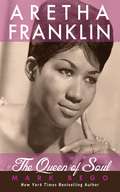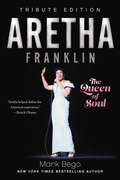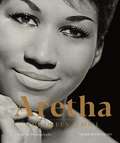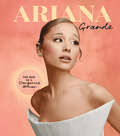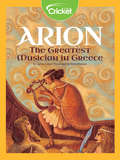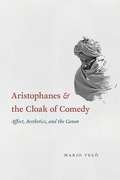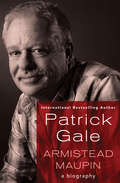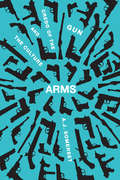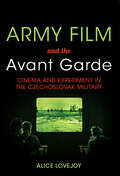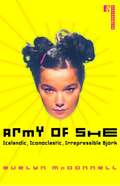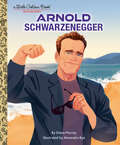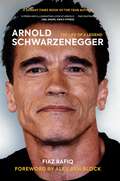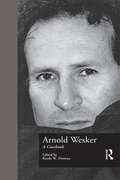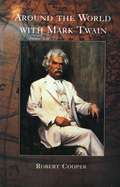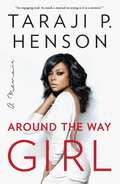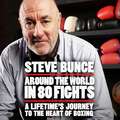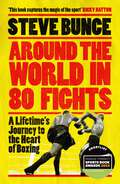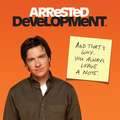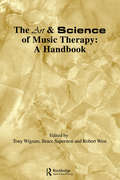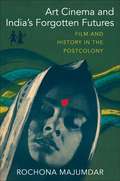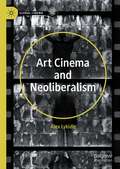- Table View
- List View
Aretha Franklin: The Queen of Soul
by Mark BegoA frank examination of Aretha Franklin, Mark Bego's definitive biography traces her career accomplishments from her beginnings as a twelve-year-old member of a church choir in the early 1950s, to recording her first album at the age of fourteen and signing a major recording contract at eighteen, right up through her headline-grabbing 2010 health scare. Originally positioned to become a gospel star in her father's Detroit church, Aretha had a privileged urban upbringing-stars such as Mahalia Jackson, Dinah Washington, and Sam Cooke regularly visited her father, Rev. C. L. Franklin. It wasn't long before she was creating a string of hits, from "Respect" to "Freeway of Love," and becoming one of the most beloved singers of the twentieth century. This New York Times bestselling author's detailed research includes in-person interviews with record producers Jerry Wexler, Clyde Otis, and Clive Davis, Aretha's first husband, several of her singing star contemporaries, and a rare one-on-one session with Aretha herself. Every album, every accolade, and every heart-breaking personal drama is examined with clarity and neutrality, allowing Franklin's colorful story to unfold on its own. With two teenage pregnancies and an abusive first marriage, drinking problems, battles with her weight, the murder of her father, and tabloid wars, Aretha's life has been a roller coaster. This freshly updated and expanded biography will give readers a clear understanding of what made Aretha Franklin the "Queen of Soul."
Aretha Franklin: The Queen of Soul
by Mark BegoA frank examination of Aretha Franklin, Mark Bego's definitive biography traces her career accomplishments from her beginnings as a twelve-year-old member of a church choir in the early 1950s, to recording her first album at the age of fourteen and signing a major recording contract at eighteen, right up through untimely passing in 2018. Originally positioned to become a gospel star in her father's Detroit church, Aretha had a privileged urban upbringing; ;stars such as Mahalia Jackson, Dinah Washington, and Sam Cooke regularly visited her father, Rev. C. L. Franklin. It wasn't long before she was creating a string of hits, from "Respect" to "Freeway of Love"; and becoming one of the most beloved singers of the twentieth century. This New York Times bestselling author's detailed research includes in-person interviews with record producers Jerry Wexler, Clyde Otis, and Clive Davis, Aretha's first husband, several of her singing star contemporaries, and a rare one-on-one session with Aretha herself. Every album, every accolade, and every heart-breaking personal drama is examined with clarity and neutrality, allowing Franklin's colorful story to unfold on its own. With two teenage pregnancies and an abusive first marriage, drinking problems, battles with her weight, the murder of her father, and tabloid wars, Aretha's life was a roller coaster. This freshly updated and expanded biography will give readers a clear understanding of what made Aretha Franklin the "Queen of Soul."
Aretha: The Queen of Soul—A Life in Photographs
by Meredith OchsThis beautifully illustrated unofficial retrospective celebrates the Queen of Soul, Aretha Franklin, and reflects on her life, music, and legacy. Aretha Franklin&’s voice was legendary, unforgettable: deeply rooted in gospel, yet versatile enough to brilliantly interpret R&B, rock, soul, pop, and jazz standards, it fueled a six-decade career. Her vocal wallop was a mix of preaching, rebuke, and elation. From the languorous &“I Never Loved a Man (the Way That I Love You),&” to the funky &“Chain of Fools,&” to the fiercely feminist &“Think,&” to the definitive, demanding version of Otis Redding&’s &“Respect,&” Franklin&’s songs played out against the tumultuous sociopolitical backdrop of the late &’60s like a soundtrack meant to set things right. Her accolades were many: she received the Kennedy Center honor in 1994, won 18 Grammys®, was the first woman inducted into the Rock and Roll Hall of Fame, and performed for presidents and the Pope. Illustrated with 85 photos, and with insightful text from noted radio personality and author Meredith Ochs, Aretha explores the diva&’s life, from her formative years growing up in Detroit, to her singing and recording career from the 1950s until her untimely death in 2018, to her numerous honors, awards, and causes, including her advocacy for civil rights and the arts.
Ariana Grande: The Rise of a Dangerous Woman
by Lisa Whittington-Hill Maura Johnston Joel Calfee Katie ConnorGet an insider&’s look at Ariana Grande's victorious performing career in this luxe hardcover gift book that's perfect for Arianators100+ stunning photos and insights from top music and culture writers explore the pop icon&’s music, style and cultural influence–and just how she&’s defied gravityThis stunning gift book immerses you in Ariana&’s world, examining her rise to stardom from her start as a young teen Nickelodeon star to the chart-topping, award winning musician and movie star she is today. Along the way this triple-threat entertainer has displayed resilience and strength, and her unabashed femininity and feminism have been a guiding light for her loyal fans.Her appeal is clear: she has a unique ability to blend artistry and activism (plus, that honeyed, four octave voice!).Inside you&’ll find: Ariana&’s many performances from singing the national anthem at local events to selling out worldwide tours Inspiration for her chart-topping, award-winning records that have sold over 90 million copies worldwide, and what makes her music so relatableAriana&’s sparkling style from red carpet appearances, tour performance outfits as well as her personal style Her business acumen in her career and the launch of R.E.M. Beauty, her own makeup lineThe impact of growing up in the spotlight on her mental health and personal relationshipsThroughout the photo-packed pages in this beautiful Ariana Grande book, fans will follow this dangerous woman&’s rise and rise to her status today as a beloved international icon. It&’s the perfect gift for any fan!
Ariane Mnouchkine (Routledge Performance Practitioners)
by Judith MillerOver the last forty years, French director Ariane Mnouchkine and her theater collective, Le Théâtre du Soleil, have devised a form of research and creation that is both engaged with contemporary history and committed to reinvigorating theater by focusing on the actor. Now revised and reissued, this volume combines: ● an overview of Mnouchkine’s life, work and theatrical influences ● an exploration of her key ideas on theater and the creative process ● analysis of key productions, including her early and groundbreaking environmental political piece, 1789, and the later Asian-inspired play penned by Hélène Cixous, Drums on the Dam. ● practical exercises, including tips on mask work. As a first step toward critical understanding, and as an initial exploration before going on to further, primary research, Routledge Performance Practitioners offer unbeatable value for today’s student.
Aries: The Art of Living Well and Finding Happiness According to Your Star Sign
by Sally KirkmanYou are an Aries. You are the pioneer and warrior of the zodiac.The signs of the zodiac can give us great insight into our day-to-day living as well as the many talents and qualities we possess. But in an increasingly unpredictable world, how can we make sense of them? And what do they mean? This insightful and introductory guide delves deep into your star sign, revealing unique traits and meanings which you didn't know. Along the way, you will discover how your sign defies your compatibility, how to improve your health and what your gifts are. ***The Pocket Astrology series will teach you how to live well and enhance every aspect of your life. From friendship to compatibility, careers to finance, you will discover new elements to your sign and learn about the ancient art of astrology. Other audiobooks in the series include: Aries, Taurus, Gemini, Cancer, Leo, Virgo, Libra, Scorpio, Sagittarius, Capricorn, Aquarius, Pisces (P)2018 Hodder & Stoughton Limited
Arion: The Greatest Musician in Greece
by James LloydArion is a famous musician in ancient Greek mythology. He loves to travel across Rome and Greece to play his music. While trying to sail home, he is robbed by a group of pirates! Fearing death, he escapes by jumping into the ocean. When all hope seems lost, he meets a dolphin that might be able to help.
Aristophanes & the Cloak of Comedy: Affect, Aesthetics, and the Canon
by Mario TelòThe Greek playwright Aristophanes (active 427–386 BCE) is often portrayed as the poet who brought stability, discipline, and sophistication to the rowdy theatrical genre of Old Comedy. In this groundbreaking book, situated within the affective turn in the humanities, Mario Telò explores a vital yet understudied question: how did this view of Aristophanes arise, and why did his popularity eventually eclipse that of his rivals? Telò boldly traces Aristophanes’s rise, ironically, to the defeat of his play Clouds at the Great Dionysia of 423 BCE. Close readings of his revised Clouds and other works, such as Wasps, uncover references to the earlier Clouds, presented by Aristophanes as his failed attempt to heal the audience, who are reflected in the plays as a kind of dysfunctional father. In this proto-canonical narrative of failure, grounded in the distinctive feelings of different comic modes, Aristophanic comedy becomes cast as a prestigious object, a soft, protective cloak meant to shield viewers from the debilitating effects of competitors’ comedies and restore a sense of paternal responsibility and authority. Associations between afflicted fathers and healing sons, between audience and poet, are shown to be at the center of the discourse that has shaped Aristophanes’s canonical dominance ever since.
Aristotle's Poetics for Screenwriters: Storytelling Secrets from the Greatest Mind in Western Civilization
by Michael TiernoAn insightful how-to guide for writing screenplays that uses Aristotle's great work as a guide.Long considered the bible for storytellers, Aristotle's Poetics is a fixture of college courses on everything from fiction writing to dramatic theory. Now Michael Tierno shows how this great work can be an invaluable resource to screenwriters or anyone interested in studying plot structure. In carefully organized chapters, Tierno breaks down the fundamentals of screenwriting, highlighting particular aspects of Aristotle's work. Then, using examples from some of the best movies ever made, he demonstrates how to apply these ancient insights to modern-day screenwriting. This user-friendly guide covers a multitude of topics, from plotting and subplotting to dialogue and dramatic unity. Writing in a highly readable, informal tone, Tierno makes Aristotle's monumental work accessible to beginners and pros alike in areas such as screenwriting, film theory, fiction, and playwriting.
Armistead Maupin (Outlines Ser.)
by Patrick GaleAn intimate biography of the gay icon whose Tales of the City changed America&’s understanding of LGBT culture during the 1970s and &’80s. Step into Armistead Maupin&’s house, and you will be greeted by a strapping young gardener, a wave of marijuana smoke, and the most gracious host in the world. When he isn&’t flitting from protests to orgies, Maupin is a natural storyteller, and San Francisco is his favorite subject. Pull up a chair and prepare to be swept away on a wave of wit, gossip, and the most outrageous sexual anecdotes you&’ve ever heard. His house seems like a scene out of his legendary Tales of the City, and that&’s no accident: Every moment of his groundbreaking series was drawn, one way or another, from Maupin&’s remarkable life, from a middle-class upbringing in North Carolina to a stint in the navy during Vietnam. Maupin landed in San Francisco just in time to chronicle the gay rights revolution that was sweeping the city and the country as a whole, and from the moment his Tales were first serialized, that city was never the same. This is an intimate biography, written by Maupin&’s longtime friend, Patrick Gale. From his fling with Rock Hudson to the darkest days of the AIDS crisis, Maupin saw it all—and lived to tell the tale.
Arms: The Culture and Credo of the Gun
by Andrew SomersetIn Arms: the Culture and Credo of the Gun, novelist, journalist, sports shooter, and former army reservist A.J. Somerset offers up one of the first looks at the gun as our pre-eminent cultural symbol of power and asks how it got that way. <P><P>Pouring through the various cultural battlefields of 19th- and 20th-century North America, including film, literature, music, videos games, and history, Somerset charts how the gun went from a tool in the hands of the earliest pioneers, used to defend the homestead and put food on the table, to a kind of totem, instantly capable of dividing communities. Sharp-eyed and acerbic, sure-handed and sportive, Arms presents an intellectual and cultural history that is certain to enrage, entertain, and provoke debate, while showing that the gun cultures of Canada and the United States may not be so different after all. If guns, as the NRA often exclaims, do not kill people, Somerset shows how the idea of the gun has become something many believe worth dying for.
Army Film and the Avant Garde: Cinema And Experiment In The Czechoslovak Military
by Alice Osborne LovejoyDuring the 1968 Prague Spring and the Soviet-led invasion and occupation that followed, Czechoslovakia's Army Film studio was responsible for some of the most politically subversive and aesthetically innovative films of the period. Although the studio is remembered primarily as a producer of propaganda and training films, some notable New Wave directors began their careers there, making films that considerably enrich the history of that movement. Alice Lovejoy examines the institutional and governmental roots of postwar Czechoslovak cinema and provides evidence that links the Army Film studio to Czechoslovakia's art cinema. By tracing the studio's unique institutional dimensions and production culture, Lovejoy explores the ways in which the "military avant-garde" engaged in dialogue with a range of global film practices and cultures. (The print version of the book includes a DVD featuring 16 short films produced by the Czechoslovak Ministry of Defense. The additional media files are not available on the eBook.)
Army of She: Icelandic, Iconoclastic, Irrepressible Björk
by Evelyn McdonnellWearing thick glasses, speaking in her thick Icelandic accent, and, well, seeming a touch thick, Björk stormed the public consciousness in 2000 as an unlikely heroine in the experimental musical film Dancer In the Dark. Army of She is an in-depth look at the woman who first took the public stage twenty-three years ago, analyzing her rise from child prodigy to punk anarchist to New Wave novelty (as member of the Sugarcubes) to hit soloist to film star.
Arnold Schwarzenegger: A Little Golden Book Biography (Little Golden Book)
by Diana MurrayHelp your little one dream big with a Little Golden Book biography about body-builder, movie star, and politician Arnold Schwarzenegger. Little Golden Book biographies are the perfect introduction to nonfiction for young readers—as well as fans of all ages!This Little Golden Book about Arnold Schwarzenegger--an immigrant from Austria who achieved the American dream and became Mr. Universe, an action movie icon, and the governor of California--is an inspiring read-aloud for young children and Terminator fans of any age. Look for more Little Golden Book biographies: • Betty White • Carol Burnett • Lucille Ball • Harry Belafonte • Julie Andrews • Dwayne Johnson
Arnold Schwarzenegger: The Life of a Legend
by Fiaz RafiqArnold Schwarzenegger – a bodybuilder-turned-real-estate mogul who turned an undefeated streak at the Mr Olympia contest into an astonishing film career and eight years as the governor of California – is, for many people, the embodiment of the American Dream. From humble beginnings in a small village in Austria, Schwarzenegger has come to symbolise the opportunities that exist for anyone willing to work hard – parlaying success and self-confidence into the influence to shape hearts and minds across the globe. Even today, whether he&’s campaigning against climate change or fist-bumping fellow strongmen at his self-titled athletic event, he&’s one of the few men on the planet who&’s recognisable from his first name alone. Arnold. Fiaz Rafiq uses in-depth interviews with Schwarzenegger&’s peers to tell the life story of the one-time Governator, featuring exclusive interviews with his personal and close friends, fellow bodybuilders and training partners, Hollywood co-stars, directors, executive producers, political personalities and journalists – all offering first-hand accounts of the man they know. Together, these voices show new dimensions to the Arnold we all think we know – from the driven young man who brought building into the mainstream to the passionate advocate for political change.
Arnold Wesker: A Casebook (Casebooks on Modern Dramatists)
by Reade W. DornanFirst Published in 1998. Routledge is an imprint of Taylor & Francis, an informa company.
Around The World With Mark Twain
by Robert CooperOn July 14, 1895, Samuel Langhorne Clemens, fifty-nine years old and deeply in debt, boarded a night train to Cleveland, launching a performance tour designed to alleviate his financial woes, and, more importantly, resuscitate his alter ego, Mark Twain. The journey took him to Fiji, Australia, New Zealand, India, and South Africa, and led to the resurrection of Twain as a celebrity. Equal parts travelogue, social history, and biography, Around the World with Mark Twain paints a decidedly different portrait of Clemens: a more tragic, darker figure who faced financial ruin and personal loss throughout his life. Around the World with Mark Twain delights while deepening our understanding of this magnificent personality.
Around the Way Girl: A Memoir
by Taraji P. HensonFrom Taraji P. Henson, Academy Award nominee, Golden Globe winner, and star of the award-winning film Hidden Figures and the 2023 film The Color Purple, comes an inspiring and funny memoir—&“a bona fide hit&” (Essence)—about family, friends, the hustle required to make it in Hollywood, and the joy of living your own truth.With a sensibility that recalls her beloved screen characters, including Katherine, the NASA mathematician, Yvette, Queenie, Shug, and the iconic Cookie from Empire, Taraji P. Henson writes of her family, the one she was born into and the one she created. She shares stories of her father, a Vietnam vet who was bowed but never broken by life&’s challenges, and of her mother who survived violence both at home and on DC&’s volatile streets. Here, too, she opens up about her experiences as a single mother, a journey some saw as a burden but which she saw as a gift. Around the Way Girl is also a classic actor&’s memoir in which Taraji reflects on the world-class instruction she received at Howard University and how she chipped away, with one small role after another, at Hollywood&’s resistance to give women, particularly women of color, meaty significant roles. With laugh-out-loud humor and candor, she shares the challenges and disappointments of the actor&’s journey and shows us that behind the red carpet moments, she is ever authentic. She is at heart just a girl in pursuit of her dreams in this &“inspiring account of overcoming adversity and a quest for self-discovery, written with vitality and enthusiasm&” (Shelf Awareness).
Around the World in 80 Fights: A Lifetime’s Journey to the Heart of Boxing
by Steve BunceAn autobiographical white-knuckle ride around the global fight game by the legendary Steve Bunce: the voice of the sport who is celebrating four decades of writing and talking about boxers and boxing."This book captures the magic of the sport - the glory and the heartache." Ricky Hatton"Steve and I go way back, all the way back. He has been ringside at all my fights, from national amateurs all the way to Wembley stadium. He is the only reporter who could have ever got close to that lift in the Garden." Anthony Joshua"Bunce is a walking talking boxing library, and is not frightened to say what he thinks and says. I've enjoyed many nights and many fights with a true legend of the game." Tyson Fury"Buncey has forgotten more than most people in boxing know." Prince Naseem Hamed"He's been there, done it and pretty much seen it all." Eddie Hearn***In Around the World in 80 Fights, let 'the Voice of Boxing' take you on the ultimate sporting odyssey: to the rings of New York, to the makeshift rings of Bukom in Ghana, to the riches of Las Vegas, and to Riyadh, Atlantic City, Bethnal Green, Mexico City, Rome and Berlin.To the basement rooms in dingy pubs where old fighters chase the last round; a bullring in December under the stars; a small square on the outskirts of Naples with a ring obscured by a fountain; the abandoned centre of boxing excellence in a forest lost in East Germany; a railway arch in south London and a bin-bag packed with cash. Let 'Buncey' tell you about the conversations with Mr. T at ringside; a meeting with the Pope's people; the thoughts of Donald Trump when he had plans to make boxing great again; Don King in exile in his nineties; an overheard conversation with Fidel Castro; and a very real diplomatic incident. The hard conversations with a dead boxer's mother in the hour after a machine had been switched off. The bravery, stupidity, guts, desire and glory of the boxers in the world's most famous and unknown rings. They fought for millions, for pride, for their country and for nothing. They bled, cried and died in those rings.Around the World in 80 Fights vividly reveals the simple, wonderful and truly awful business of boxing. It is Buncey's business and this is his story.***"Steve has a great knowledge of our sport." Joe Calzaghe"Bunce captured the madness in Memphis around the fight with Tyson... the behind-the-scenes story of the Bruno fight and was there from York Hall to Las Vegas." Lennox Lewis"His love and enthusiasm for the sport is infectious." Katie Taylor"Steve understands how the minds of boxers tick." Carl Froch"Steve's knowledge on the sweet science of boxing is second to none." Carl Frampton
Around the World in 80 Fights: A Lifetime’s Journey to the Heart of Boxing
by Steve BunceAn autobiographical white-knuckle ride around the global fight game by the legendary Steve Bunce: the voice of the sport who is celebrating four decades of writing and talking about boxers and boxing."This book captures the magic of the sport - the glory and the heartache." Ricky Hatton"Steve and I go way back, all the way back. He has been ringside at all my fights, from national amateurs all the way to Wembley stadium. He is the only reporter who could have ever got close to that lift in the Garden." Anthony Joshua"Bunce is a walking talking boxing library, and is not frightened to say what he thinks and says. I've enjoyed many nights and many fights with a true legend of the game." Tyson Fury"Buncey has forgotten more than most people in boxing know." Prince Naseem Hamed"He's been there, done it and pretty much seen it all." Eddie Hearn***In Around the World in 80 Fights, let 'the Voice of Boxing' take you on the ultimate sporting odyssey: to the rings of New York, to the makeshift rings of Bukom in Ghana, to the riches of Las Vegas, and to Riyadh, Atlantic City, Bethnal Green, Mexico City, Rome and Berlin.To the basement rooms in dingy pubs where old fighters chase the last round; a bullring in December under the stars; a small square on the outskirts of Naples with a ring obscured by a fountain; the abandoned centre of boxing excellence in a forest lost in East Germany; a railway arch in south London and a bin-bag packed with cash. Let 'Buncey' tell you about the conversations with Mr. T at ringside; a meeting with the Pope's people; the thoughts of Donald Trump when he had plans to make boxing great again; Don King in exile in his nineties; an overheard conversation with Fidel Castro; and a very real diplomatic incident. The hard conversations with a dead boxer's mother in the hour after a machine had been switched off. The bravery, stupidity, guts, desire and glory of the boxers in the world's most famous and unknown rings. They fought for millions, for pride, for their country and for nothing. They bled, cried and died in those rings.Around the World in 80 Fights vividly reveals the simple, wonderful and truly awful business of boxing. It is Buncey's business and this is his story.***"Steve has a great knowledge of our sport." Joe Calzaghe"Bunce captured the madness in Memphis around the fight with Tyson... the behind-the-scenes story of the Bruno fight and was there from York Hall to Las Vegas." Lennox Lewis"His love and enthusiasm for the sport is infectious." Katie Taylor"Steve understands how the minds of boxers tick." Carl Froch"Steve's knowledge on the sweet science of boxing is second to none." Carl Frampton
Around the World in 80 Fights: A Lifetime’s Journey to the Heart of Boxing
by Steve BunceAn autobiographical white-knuckle ride around the global fight game by the legendary Steve Bunce: the voice of the sport who is celebrating four decades of writing and talking about boxers and boxing."This book captures the magic of the sport - the glory and the heartache." Ricky Hatton"Steve and I go way back, all the way back. He has been ringside at all my fights, from national amateurs all the way to Wembley stadium. He is the only reporter who could have ever got close to that lift in the Garden." Anthony Joshua"Bunce is a walking talking boxing library, and is not frightened to say what he thinks and says. I've enjoyed many nights and many fights with a true legend of the game." Tyson Fury"Buncey has forgotten more than most people in boxing know." Prince Naseem Hamed"He's been there, done it and pretty much seen it all." Eddie Hearn***In Around the World in 80 Fights, let 'the Voice of Boxing' take you on the ultimate sporting odyssey: to the rings of New York, to the makeshift rings of Bukom in Ghana, to the riches of Las Vegas, and to Riyadh, Atlantic City, Bethnal Green, Mexico City, Rome and Berlin.To the basement rooms in dingy pubs where old fighters chase the last round; a bullring in December under the stars; a small square on the outskirts of Naples with a ring obscured by a fountain; the abandoned centre of boxing excellence in a forest lost in East Germany; a railway arch in south London and a bin-bag packed with cash. Let 'Buncey' tell you about the conversations with Mr. T at ringside; a meeting with the Pope's people; the thoughts of Donald Trump when he had plans to make boxing great again; Don King in exile in his nineties; an overheard conversation with Fidel Castro; and a very real diplomatic incident. The hard conversations with a dead boxer's mother in the hour after a machine had been switched off. The bravery, stupidity, guts, desire and glory of the boxers in the world's most famous and unknown rings. They fought for millions, for pride, for their country and for nothing. They bled, cried and died in those rings.Around the World in 80 Fights vividly reveals the simple, wonderful and truly awful business of boxing. It is Buncey's business and this is his story.***"Steve has a great knowledge of our sport." Joe Calzaghe"Bunce captured the madness in Memphis around the fight with Tyson... the behind-the-scenes story of the Bruno fight and was there from York Hall to Las Vegas." Lennox Lewis"His love and enthusiasm for the sport is infectious." Katie Taylor"Steve understands how the minds of boxers tick." Carl Froch"Steve's knowledge on the sweet science of boxing is second to none." Carl Frampton
Arrested Development: And That's Why . . . You Always Leave a Note.
by Arrested DevelopmentAnd now the story of a wealthy family who lost everything, and the one son who had no choice but to keep them all together . . . ItOCOs "Arrested Development. " Meet the formerly wealthy and habitually dysfunctional Bluth family. When the family patriarch George Sr. is sent to prison for shifty accounting practices, the Bluths must face reality?or not. Since the family assets have been frozen and the family business is in jeopardy, it looks like they may have to give up their lavish lifestyle. Worse yet, they may have to go out and get jobs The only one who seems to understand the seriousness of their predicament is Michael, who realizes itOCOs up to him to guide his eccentric family into this new chapter of their lives: Chapter 11. Full of the most memorable quotes and images from some of the best moments from the original three seasons of the show, "Arrested Development: And ThatOCOs Why . . . You Always Leave a Note" offers valuable life lessons from Michael, G. O. B. , Lucille, George Sr. , Lindsay, George Michael, Tobias, and the rest of the Bluth gang with chapters including: Family First, Huge Mistakes, Parental Guidance, Risky Business, and more. Relive all your favorite A"rrested Development" moments with this must-have companion to the ground-breaking comedy series. "
Art & Science of Music Therapy: A Handbook
by Tony Wigram Robert West Bruce SaperstonFirst Published in 1995. Routledge is an imprint of Taylor & Francis, an informa company.
Art Cinema and India’s Forgotten Futures: Film and History in the Postcolony
by Rochona MajumdarThe project of Indian art cinema began in the years following independence in 1947, at once evoking the global reach of the term “art film” and speaking to the aspirations of the new nation-state. In this pioneering book, Rochona Majumdar examines key works of Indian art cinema to demonstrate how film emerged as a mode of doing history and that, in so doing, it anticipated some of the most influential insights of postcolonial thought.Majumdar details how filmmakers as well as a host of film societies and publications sought to foster a new cinematic culture for the new nation, fueled by enthusiasm for a future of progress and development. Good films would help make good citizens: art cinema would not only earn global prestige but also shape discerning individuals capable of exercising aesthetic and political judgment. During the 1960s, however, Satyajit Ray, Mrinal Sen, and Ritwik Ghatak—the leading figures of Indian art cinema—became disillusioned with the belief that film was integral to national development. Instead, Majumdar contends, their works captured the unresolvable contradictions of the postcolonial present, which pointed toward possible, yet unrealized futures.Analyzing the films of Ray, Sen, and Ghatak, and working through previously unexplored archives of film society publications, Majumdar offers a radical reinterpretation of Indian film history. Art Cinema and India’s Forgotten Futures offers sweeping new insights into film’s relationship with the postcolonial condition and its role in decolonial imaginations of the future.
Art Cinema and Neoliberalism (Global Cinema)
by Alex LykidisArt Cinema and Neoliberalism surveys cinematic responses to neoliberalism across four continents. One of the first in-depth studies of its kind, this book provides an imaginative reassessment of art cinema in the new millennium by showing how the exigencies of contemporary capitalism are exerting pressure on art cinema conventions. Through a careful examination of neoliberal thought and practice, the book explores the wide-ranging effects of neoliberalism on various sectors of society and on the evolution of film language. Alex Lykidis evaluates the relevance of art cinema style to explanations of the neoliberal order and uses a case study approach to analyze the films of acclaimed directors such as Asghar Farhadi, Yorgos Lanthimos, and Lucrecia Martel in relation to the social, political, and cultural characteristics of neoliberalism. By connecting the aesthetics of art cinema to current social antagonisms, Lykidis positions class as a central concern in our understanding of the polarized dynamics of late capitalism and the escalating provocations of today’s film auteurs.
